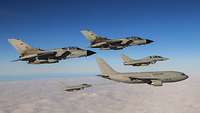The German Air Force in Transformation – Fit for the Future
Air Force- Reading time:
- 3 MIN



Eurofighter combat aircraft of 31 Tactical Air Wing and Tornado combat aircraft of 33 Tactical Air Wing flying together with an Airbus A310 MRTTMulti Role Tanker Transport (Multi Role Tanker Transport) refueling aircraft at the Air Force base in Laage, Germany.
Bundeswehr/Stefan PetersenThe security environment of Germany, NATONorth Atlantic Treaty Organization (North Atlantic Treaty Organization) and the European Union is constantly changing. This also affects the context in which the German Air Force has to fulfil its mission. The German Air Force consistently adapts to the requirements of the future operating environment with various measures and projects. The most important fields of action in this respect are operational readiness, modernization, digitalization and multinational orientation.
The German Air Force’s mission is to provide a credible contribution to national and collective defense and to international crisis management. This is only possible if the materiel and weapon systems are operational. Equally, military personnel can only fulfil their mission if the materiel and weapon systems that they use on operations are also available to them during training and exercises. For this to be achieved, the operational readiness of the German Air Force’s weapon systems will have to be increased considerably in the coming years.
The German Air Force will have to completely modernize many of its capabilities in the next years. This includes the procurement of a successor system for the Tornado combat aircraft, the replacement of the CH-53 transport helicopters and the development of the Eurodrone together with France, Italy and Spain.
The development of the Tactical Air Defense System ensures that ground-based air defense will be capable of coping with the complex threats of the future, for example those posed by novel missiles and drones. Those weapon systems will shape tomorrow’s appearance of the German Air Force.
One project in particular will determine the character of at least the German, French and Spanish air forces and provide the backbone of the German Air Force from the forties of this century: the joint development of the Next Generation Weapon System (NGWSNext Generation Weapon System), a future airborne weapon system.
At the same time, the German Air Force will extend its responsibility for the third dimension to near-earth space. In the coming years, the German Air Force will gain the ability to precisely locate objects in space with own sensors, assess their behavior and share this information with multinational partners in order to provide political decision-makers with options when our freedom of action in space is threatened.
Today, no state is able to face the multiple challenges in the security environment of the 21st century on its own. Therefore, the German Air Force has been closely integrated into international organizations since its formation, fulfilling its mission alongside partners and allies. For this purpose, it also assumes responsibility in leading positions, for example in the context of the creation of a multinational air transport unit or the provision of the NATONorth Atlantic Treaty Organization (North Atlantic Treaty Organization) Very High Readiness Joint Task Force Air in 2023.
The area of civilian ITInformationstechnik has evolved rapidly over the last years. The German Air Force has realized that there are a number of innovations that could also be of significance for the German Air Force when it comes to increasing its operational effectiveness. Therefore, it has dedicated a large number of projects, plans and studies to digital transformation. Digitalization is more than just connecting computers or transferring analog processes – it is also about establishing a digital mentality to support mission accomplishment, taking into account the opportunities and risks that the new possibilities involve.
by Kommando Luftwaffe
Those who stop getting better have stopped being good!